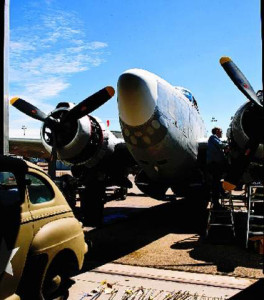
Stockton Record – April 17, 2011
In 1945, as American military strategists laid plans to invade Japan, the U.S. Navy ordered a new patrol bomber airplane: the Lockheed PV-2 Harpoon.
Lockheed manufactured only 35 of the final version, the PV-2D, before the atomic bomb abruptly ended the war. Only one still flies. Preservationists based at Stockton’s airport recently acquired this rare bird.
“It’s kind of like getting the keys to the Statue of Liberty or the Washington Monument and taking it out for a spin,” said Ken Terpstra. “That’s how much a part of our history this airplane actually is.”
Terpstra is Vice President of Stockton Field Aviation Museum, a surprising private collection of large and small WWII artifacts in the process of becoming a public museum.
The purpose of the organization, which takes its name from a WWII Stockton airbase, and is in a hangar, is “to educate the public about the sacrifices our veterans have made … and to honor them with actual working restorations of the tools they used.”
The PV-2D was a deadly tool. A six-man crew could fly the 75-foot aircraft 1,790 miles with 4,000 pounds of bombs in its belly, and two 1,000-pound bombs under its wings, or eight rockets.
In addition, the plane bristled with eight .50 caliber machine guns in its nose and two fired by a top turret gunner. It also had an advanced “radome” radar in its nose.
These capabilities allowed the PV-2 series to hunt enemy ships and subs or fly out of bases as remote as the Aleutian Islands on bombing runs all the way to Japanese-occupied islands in the South Pacific.
“I can’t imagine flying over the water that far, arriving at a small island out in the middle of nowhere, dropping your bombs and getting back,” said Terpstra.
The Harpoon was also designed to support America’s land invasion of the Japanese home islands. But V-J Day arrived before the museum’s Harpoon saw action.
The plane was flown straight to a boneyard in Arizona. There, protected from corrosion by desert air, it sat until 1959.
Finally, with only seven hours of flying time on it, the plane was declared surplus, sold and modified into an air tanker.
It alternated fighting fires from Pennsylvania to Idaho with down time, racking up only 800 hours of flying time – relatively few compared with other planes that flew up to 7,000 when modified into private transports or ag-spray planes.
It is the airborne equivalent of the car the little old lady drove to church only on Sundays.
A private collector bought the Harpoon in 1994. He parked it on his land near Hidden Valley. He did nothing with it for six years.
An Alaskan firm that distributes gasoline by airplane bought the plane in 2000 with the idea of retrofitting more engines on it flying fuel to remote customers.
Their plans didn’t work out. The plane remained unclaimed in Hidden Valley. The Alaskans offered it to the museum late last year.
Museum President Taigh Ramey recalled when he flew a crew up to a dirt airstrip outside Hidden Valley and first laid eyes on the old warbird.
“It was on the ground, buried up to the axles and up to its belly in reeds,” said Ramey. “All sorts of squirrels and critters were living in it. She looked pretty sorry.”
But the plane still had no corrosion. As for the two 2,000 hp Pratt & Whitney engines, reportedly able to outrun a Japanese Zero – “The first day we got the first engine running – after 16 years,” Ramey marveled. Added Terpstra, “It was like she wanted to get back in the air.”
Deciding the plane was salvageable, the museum staff obtained special permission from the FAA to fly it to Stockton. They have been restoring it ever since.
It is the only D series Harpoon flying, one of three out of the entire A-D production series still in the air.
The next stage is to restore the U.S. Navy’s WWII paint job of “Non-Specular Sea Blue” (flat blue) an estimated $10,000 task.
The museum is seeking veterans’ groups, service clubs or private citizens willing to make a tax-deductible donation.
It also welcomes donations of WWII aviation artifacts. Donate by calling (209) 982-0273 or emailing Terpstra at Redtracer20001@sbcgobal.net.
“We want it to be a time capsule people can step into and see what their fathers and grandfathers did,” Terpstra said of the plane. “We want this to be a flying tribute not only to our WWII vets but all vets. Without them, we wouldn’t have the freedoms we have today.”
Contact columnist Michael Fitzgerald at (209) 546-8270 or michaelf@recordnet.com.
